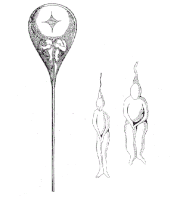
Back التكون المسبق للكائنات Arabic Preformizm Azerbaijani Präformationslehre German Preformacionismo Spanish Preformism Estonian Théorie de la préformation French Preformacionismo Galician Պրեֆորմիզմ Armenian Praformasionisme ID Preformismo Italian


In the history of biology, preformationism (or preformism) is a formerly popular theory that organisms develop from miniature versions of themselves. Instead of assembly from parts, preformationists believed that the form of living things exist, in real terms, prior to their development.[1] Preformationists suggested that all organisms were created at the same time, and that succeeding generations grow from homunculi, or animalcules, that have existed since the beginning of creation, which is typically defined by religious beliefs.
Epigenesis[2] (or neoformism),[3] then, in this context, is the denial of preformationism: the idea that, in some sense, the form of living things comes into existence. As opposed to "strict" preformationism, it is the notion that "each embryo or organism is gradually produced from an undifferentiated mass by a series of steps and stages during which new parts are added" (Magner 2002, p. 154).[4] This word is still used in a more modern sense, to refer to those aspects of the generation of form during ontogeny that are not strictly genetic, or, in other words, epigenetic.
Apart from those distinctions (preformationism-epigenesis and genetic-epigenetic), the terms preformistic development, epigenetic development and somatic embryogenesis are also used in another context, in relation to the differentiation of a distinct germ cell line. In preformistic development, the germ line is present since early development. In epigenetic development, the germ line is present, but it appears late. In somatic embryogenesis, a distinct germ line is lacking.[5] Some authors call Weismannist development (either preformistic or epigenetic) that in which there is a distinct germ line.[6]
The historical ideas of preformationism and epigenesis, and the rivalry between them, are obviated by the contemporary understanding of the genetic code and its molecular basis together with developmental biology and epigenetics.
- ^ Maienschein, Jane, "Epigenesis and Preformationism", The Stanford Encyclopedia of Philosophy (Fall 2008 Edition), Edward N. Zalta (ed.).
- ^ According to the Oxford English Dictionary:
It is also worth quoting this adumbration of the definition given there (viz., "The formation of an organic germ as a new product"):The word is used by W. Harvey, Exercitationes 1651, p. 148, and in the English Anatomical Exercitations 1653, p. 272. It is explained to mean 'partium super-exorientium additamentum', 'the additament of parts budding one out of another'.
theory of epigenesis: the theory that the germ is brought into existence (by successive accretions), and not merely developed, in the process of reproduction. ... The opposite theory was formerly known as the 'theory of evolution'; to avoid the ambiguity of this name, it is now spoken of chiefly as the 'theory of preformation', sometimes as that of 'encasement' or 'emboîtement'.
- ^ Callebaut, Marc, 2008: Historical evolution of preformistic versus neoformistic epigenetic thinking in embryology. Belgian Journal of Zoology 138(1): 20-35.
- ^ Magner, Lois. A History of the Life Sciences. New York: Marcel Dekker, Inc, 2002
- ^ Buss, L.W. (1987). The Evolution of Individuality. Princeton University Press, Princeton, NJ, p. 20 [1].
- ^ Ridley M (2004) Evolution, 3rd edition. Blackwell Publishing, p. 295-297.
© MMXXIII Rich X Search. We shall prevail. All rights reserved. Rich X Search